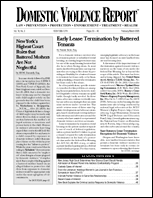The Dangers of Dangerousness Assessment
Author: Evan Stark, Ph.D., MSW.
Source: Volume 17, Number 05, June/July 2012 , pp.65-68(4)

next article > |return to table of contents
Abstract:
This comment responds to two related claims made in recent DVR articles, that preventing partner homicides (or potentially fatal violence) should be a major goal of community efforts to limit domestic violence, and that this goal is best pursued by using “dangerousness assessment” (DA), alternately termed a “lethality screen,” to allocate scarce justice resources (such as electronic monitoring or enhanced sanctions). The author’s argument is that partner homicide (and severe violence generally) are poor windows through which to assess domestic violence and that redirecting scarce resources based on DA is not only unwise but counterproductive. At best, it will have a very limited and no measureable effect on partner fatality or severe violence and no effect at all on the prevalence of partner abuse in communities. It is likely that redirecting resources to support women the DA identifies as high risk or to identify and manage so-called “high risk” offenders (as the DVR articles propose) will lead to an actual rise in coercive control, the most common and devastating form of partner abuse. The major reasons to reject DA are that the elements of abuse it identifies as high risk factors are sufficiently harmful in themselves to justify an aggressive response that includes significant sanctions regardless of their future consequences. So are the facets of coercive control the DA minimizes or ignores. He remains “agnostic” about other claims in the articles, such as the wisdom of adapting GPS tracking.Keywords: Abuse-Related Fatalities and Near Fatalities Too Rare to be Basis for Intervention Tool; Level of Control in Relationship Predicts Subsequent Harm Better Than the Level, Frequency, or Nature of Physical Violence
Affiliations:
1: Rutgers University .